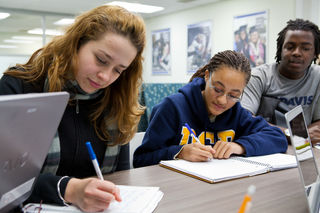Education
3 Ways Behavioral Science Is Impacting College Students
Retention experts shared strategies and lessons at a recent national symposium.
Posted December 4, 2017

Behavioral science is increasingly on the minds and in the practices of college educators across the country. That much was apparent at the What’s in a Nudge? panel last month at the National Symposium on Student Success. In front of a standing room only crowd, experts from both community colleges and four-year universities came together to discuss how nudging is a key component of their campus’ efforts to keep students on track to graduation. These strategies illustrate how higher education is thinking about behavioral science as an innovative and powerful tool for engaging students and increasing persistence. Three key themes that emerged from the panel were how behavioral science can:
- Help students plan for the future;
- Redefine what is “normal” on campus, and;
- Teach colleges more about what is holding their students back.
Helping Students Plan for the Future
Multiple panelists discussed the utility of behavioral science for helping students fulfill their short- and long-term goals. Dr. Adrienne Maslin, Dean of Students at Middlesex Community College (CT), shared how they are using SMS-based nudging to encourage incoming students to name the where, when, and how for achieving their goals, also known as implementation intentions. Ohio University, in their reconceptualization of the first-year experience, is also teaching this goal-setting strategy to first-generation students through a combination of SMS-based nudges, in-person orientation, and online education. Dr. Loralyn Taylor, Director of Analytics for University Student Success Initiatives, shared how implementation intentions are one example of the “wise interventions” that OHIO is leveraging to change not just students’ behaviors, but also the attitudes and beliefs underlying those behaviors so that those changes stick.
Redefining Normal
Social norms are a powerful influence on behavior, especially when we find ourselves in complex and ambiguous situations—and perhaps no two words better describe the beginning of college. Dr. Sara Kelly, Associate Dean of Students and Director of Residential Life at The College at Brockport (SUNY), discussed how they’re leveraging social norms to help underrepresented students acclimate to life on campus. Since 2014, Brockport has more than doubled the number of Resident Assistants from underrepresented populations so that norms around success and leadership are ascribed to students from all backgrounds. OHIO is helping first-generation students adopt norms around college as a place that fosters interdependence (e.g., working in teams; helping others), a value that tends to resonate with first-generation students more so than does independence. And Middlesex is using the power of norms to change students’ attitudes toward help seeking by reducing stigma and fear around going to see a tutor and talking to professors.
Teaching Colleges about their Students
The panelists also emphasized how effective behavioral interventions can uncover new insights about their students that, in turn, inform their future strategies for student support. Bob Mong, President of the University of North Texas at Dallas, discussed how his campus used SMS-based nudges to provide an extra layer of support to those students almost finished with college (i.e., near completers) rather than those starting out. This program revealed lingering issues with the accuracy of students’ knowledge of their progress toward a degree, which led UNT Dallas to reevaluate their approach to transfer credits and the graduation application process. Dr. Maslin also described how Middlesex’s nudging program shed light on additional obstacles to success for adult learners returning to college after time away from education. This knowledge led Middlesex to create a College Success Boot Camp and AtLast! (adult learner student team) to help these students transition into and succeed in college.
Looking Ahead
It will be exciting to see how the diverse blend of retention experts in the room—from small liberal arts colleges to multi-campus community colleges and massive four-year universities—take what they learned from What’s in a Nudge? and apply it back on campus. By the time we welcome the class of 2018, I’m sure we’re going to see even more student success strategies based on principles of behavioral science. But the examples provided by the panelists are just the tip of the iceberg when it comes to the opportunities within higher education afforded by behavioral science, and continuing to share these efforts will keep us all informed of best practices in this field.
References
Gollwitzer, P. M. (1999). Implementation intentions: Strong effects of simple plans. American Psychologist, 54(7), 493.
Walton, G. M. (2014). The new science of wise psychological interventions. Current Directions in Psychological Science, 23(1), 73-82.
Yeager, D. S., Walton, G. M., Brady, S. T., Akcinar, E. N., Paunesku, D., Keane, L., ... & Gomez, E. M. (2016). Teaching a lay theory before college narrows achievement gaps at scale. Proceedings of the National Academy of Sciences, 113(24), E3341-E3348.


